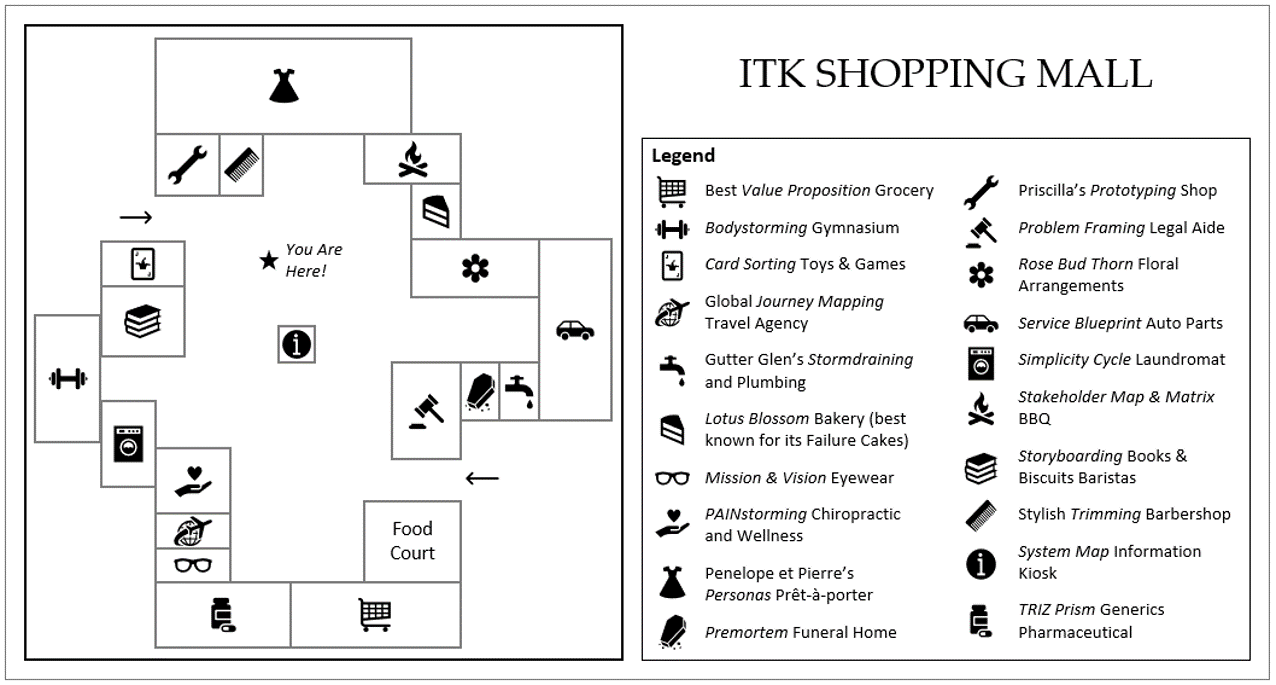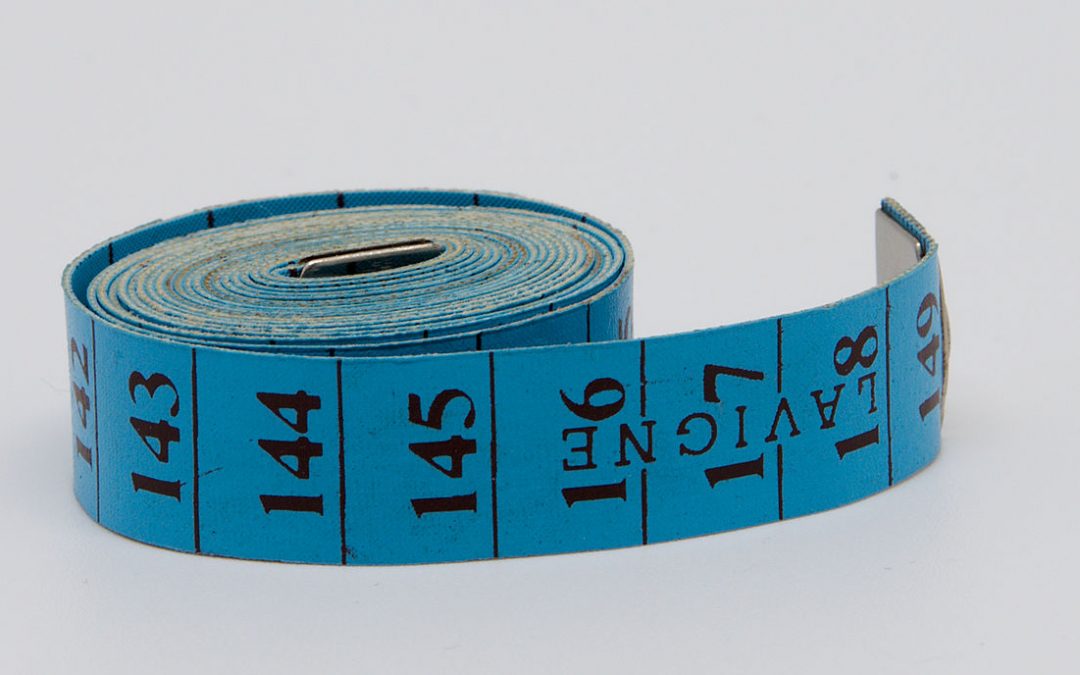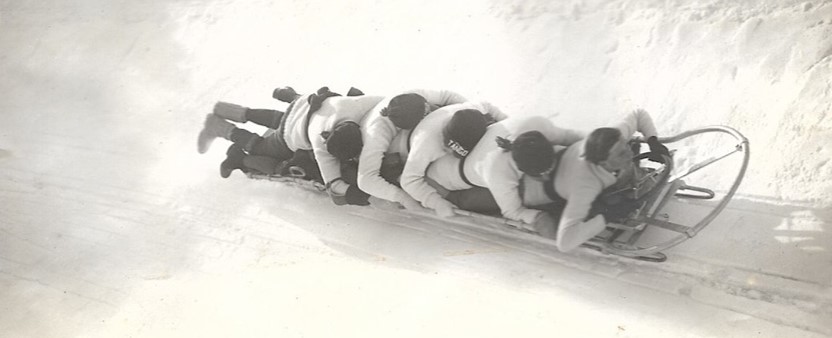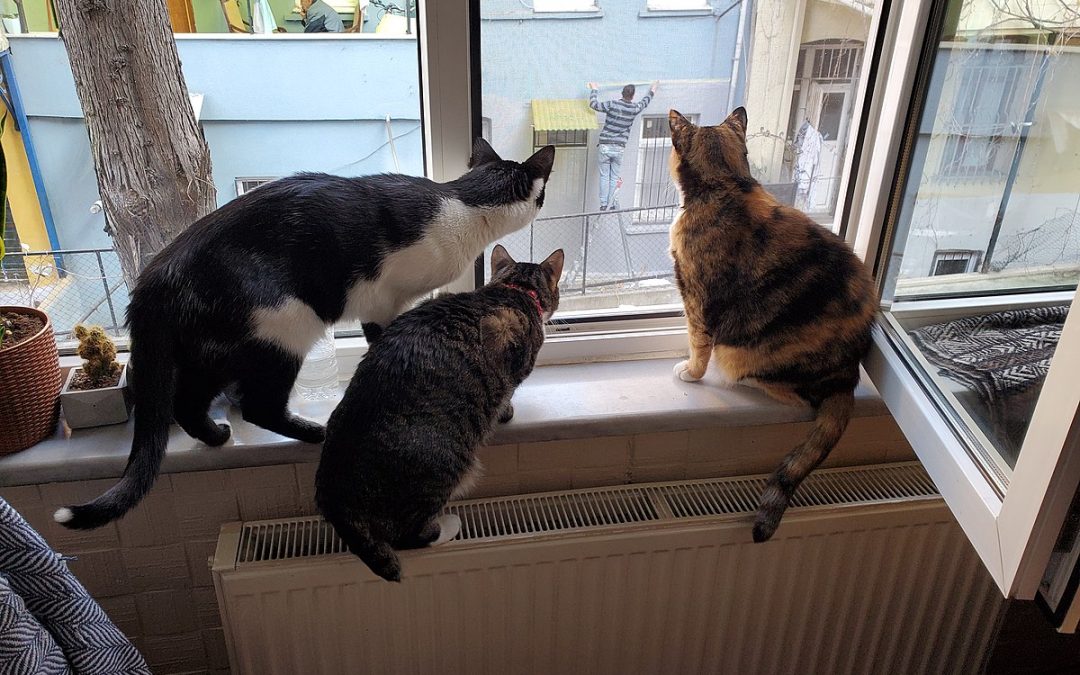
by dbward | Mar 28, 2022 | Misc Awesomeness, Success Stories |
This week’s post is by guest blogger Allison Khaw!
A few weeks ago, on my own time, I dove into a short-term creative project.
I was inspired by Karim Thompson on the Innovation Toolkit team: he invented a list of fictional strip mall business names based on some of the ITK tools. Functionally, the list helped you remember the tool names, but its intangible benefits went well beyond that. I remember how so many of us on the team were not only entertained but also energized by what he created. At some point, I concluded—this can’t be forgotten in the annals of team history!
Adapting Karim’s list into a more visual format seemed like a natural next step. I expanded the original list by adding a few business names of my own, and then I formed a map legend and designed a map layout. Several versions later, the final “ITK Shopping Mall Map” was born! It was quite an iterative process, and looking back, I asked myself:
What takeaways do I want to share as a result of this experience?
- Don’t limit yourself to a certain approach just because that’s how it’s been done before.
From the start, I planned to include this shopping mall map in our ITK Handbook, which is an ITK how-to guide and an informal sequel to our choose-your-own-adventure-style book The Toolbox of Innovation. Since I made line drawings by hand for our first book to resemble the CYOA books of the 80’s and 90’s, I originally planned to draw the map by hand as well. However, I realized that the non-CYOA style of the ITK Handbook opened up other possibilities. In fact, only after letting go of the “It’s always been done this way before!” argument did it become clear to me that electronically creating the map was the better option to begin with.
- Set yourself up for exploring new ideas by periodically saving backup versions.

I decided to keep it simple by using PowerPoint as my creation software. As I developed the map, I got into the habit of duplicating my in-progress version and then working off of the newer copy, which resulted in dozens of sequential PowerPoint slides. Although this was a basic technique (thank you, copy and paste!), it made all the difference. It allowed me to incrementally move forward with new ideas in the design process—and if I liked an old idea better, I could always find my way back. To illustrate this, see the provided figure with four map versions at different points in the brainstorming process. Some versions were considerably better than others!
- To leave yourself room for inspiration, set minimal expectations and build flexibility around deadlines.
Given the nature of this side project, no one would have been upset if I didn’t finish it. In many ways, this was incredibly freeing. I was self-motivated to see my vision come to fruition, but I took my time looking into common shopping mall layouts and actually discovered one of my best design ideas after a leisurely session of experimentation. Even for projects with fixed deadlines, starting early to give yourself flexibility can be invaluable. Yes, sometimes constraints are useful, but other times the feeling of not being rushed can be exactly what you need to achieve results.
- The end result may seem obvious in hindsight, but the path it takes to get there is often quite the opposite.
A final product that looks simple and effortless usually belies the very effort that you put into it. What’s more, this is a good thing—it means that your hard work has paid off! I have experienced this before when using the Premortem and Mission & Vision Tool, and I found this to be true here too after following a winding path to reach the final design of the map. Blaise Pascal summarized it nicely back in the seventeenth century, when he is said to have penned, “I would have written a shorter letter, but I didn’t have the time.” We need to more consistently give ourselves the opportunity to go that extra mile—and write that shorter letter.
This side project was fulfilling in that it allowed me to breathe new life into the fictional ITK business names that Karim created. Not only did I learn valuable lessons from the iterative nature of the map design process, but each time I look back at the completed ITK Shopping Mall Map, I can’t help but grin at everything it represents.
More than anything, I consider that a measure of success if ever there was one. Best of luck on your own creative pursuits!

by dbward | Mar 14, 2022 | Uncategorized
People often ask us how to measure the results of an innovation program. And in truth, the value of these programs is often hard to determine, particularly when we treat innovation as the goal, rather than (correctly!) viewing innovation as a means to an end. And so we end up counting artifacts (i.e. publications, attendees, participants, etc) rather than measuring the actual output of the program (i.e. what problems did we solve, what value did we create, what improvements did we make, etc).
Now, it’s hard to measure something if you don’t know what it is. That’s why I recommend we look to ITK’s definition of innovation (“novelty with impact”) before creating our measurement plans. That three-word definition points us towards the thing we should be monitoring and measuring – the output of our innovation efforts. It centers our discussion on WHY we do innovation in the first place, because it poses the question “What impact are we trying to have?”
Once we know what impact we’re trying to have, it’s pretty obvious what we should measure. If our innovation is “a new technology that saves lives,” then obviously the thing we should measure is the number of lives we’ve saved. If the innovation is “a new process that saves time,” the thing to measure is how much time we saved. If we’re looking across a portfolio of innovation projects, adding up all those measurable impacts will give us a good sense of the portfolio’s success or failure.
In contrast, if our goal is just to “be innovative” then we’ll probably have a hard time figuring out what to measure.
Defining innovation as “novelty with impact” also helps us avoid the superficial version of innovation that overemphasizes newness and underplays impact. It points out that innovation without impact is not innovation, it’s just novelty. When we keep that in mind, we’re more likely to get the results we hoped for.
photo credit: Clément Bucco-Lechat

by dbward | Mar 7, 2022 | shared leadership
Today’s blog post is by Niall White
Want more great leaders? Be a great follower.
I’m convinced there are many potentially great leaders in the world. Of these potential leaders, I sometimes wonder if many are simply afraid to step forward. This fear could come from many different sources; fear of failure, fear of rejection, lack of confidence, or even a lack of understanding, to name a few. It is also possible that this fear comes from negative experiences or deeply personal mental illness. It may be impossible to know every reason why someone is reluctant to step forward as a leader, but it is possible to help them.
Being a “follower” can sometimes come with a negative connotation, but some of the great leaders I’ve known were also great followers. Rather than thinking of a follower only as someone that simply goes through the motions, doing whatever they are told with little proactivity, I invite you to consider an alternative viewpoint: A follower can be someone that not only makes way for someone else to lead, but provides positive reinforcement, kind and productive criticism, and looks for their own leadership opportunities that support the leader (e.g., volunteering to help or pursuing a recommendation). In short; friendly following. Now, it’s probably worth mentioning that, just like the phrase “yes, and”, you don’t need to follow, endorse, or agree with something you aren’t comfortable with.
Can you imagine a world where people of all backgrounds and experiences, strengths, and limitations, felt empowered to lead in whatever capacity they could? And can you imagine if they not only felt empowered to lead, but believed that their message would be received by people that were open to new ideas, willing to help, and helpful enough to provide courteous feedback? Dare I say, friendly followers? I imagine that world would have a lot less fear. I’ve seen teams, families, and organizations that operate this way, and I can say that these are the teams, families, and organizations that I’ve felt the most safety and satisfaction being associated with.
Think about the friendly followers around you. I can think of many at here at MITRE. I can think of many in the ITK community! Volunteering to co-facilitate a workshop with someone, giving someone the benefit of the doubt when they are slow to respond to an inquiry, assuming good intent when a statement is made, and enabling an environment where others feel safe, are all examples of friendly following.
I really do believe that there are many incredible people all around us that are reluctant to step forward, stand in the limelight, or even be noticed. How might we be a source of strength and encouragement for these potential leaders? How might we be friendly followers so that others might lead?
cover image by Doug Coldwell

by dbward | Feb 21, 2022 | Misc Awesomeness
As the 2022 Winter Olympics come to a close, I find myself thinking about the concept of being “the best.” In Olympic competitions of course, each event awards a gold medal to a competitor who comes out ahead in a rigorous competition. They are The Best.
In some events, the difference between gold and a non-medal fourth place is measured in fractions of a second. I even saw situations where an athlete’s performance broke the previous world record, but they still came in fourth because three other people were oh-so-slightly faster. Clearly, the gold medalists aren’t the only ones doing excellent work. In other events, the difference between first and fourth is more pronounced. For example, Italy’s mixed doubles curling team had a perfect 11-0 record in the round-robin tournament, and they played nearly flawless matches, absolutely dominating the field. In the fourth end of their match against Norway… but I digress.
The point is, this whole thing got me thinking about one of my favorite questions: Who are the top performers in YOUR field?
In any field or discipline, some people will simply do the work better than most. Take a moment to think about what you do – can you name the people who set the bar in your particular field? Who are the leading voices, the practitioners who deliver outstanding results, the ones who would wear gold medals if such things were awarded? Keep in mind that the list of top performers will change over time. Nobody stays in the winner’s circle forever and even Shaun White came in fourth in the half-pipe competition this year. So this is a good question to ask on a regular basis as new players enter the stage and surpass previous records. Once you’ve got a list of top people in your field, you may want to ask a few additional questions:
- What makes them a top performer?
- What do they do differently?
- What can we learn from them?
- Could we reach out to them?
- Partner with them?
As I watched the Olympics this year, I was struck by how often the commentators described the relationships between competitors. They all knew each other and learned from each other. They competed against each other many times before arriving at the Olympics. They made each other better. I think there is a lesson there for all of us.
Image Credit: The 1913 Saint-Moritz Bobsleigh Derby Cup by Albert Ewald

by dbward | Feb 14, 2022 | Facilitation Tips
Here in ITK land, we aim to foster an atmosphere of curiosity everywhere we go. Most of us are pretty curious by nature, and ITK work is full of opportunities to indulge our “strong desire to know.” Naturally, pretty much all the tools in our toolkit are question-based, and are designed to draw out thoughts, ideas, and perspectives from the groups we work with. Our facilitation techniques are similarly focused on helping teams dig deeper, explore new areas, and learn new things together.
The truth is, curiosity is an action as much as an identity. It’s what we do as much as who we are. And the good news is that curiosity-as-a-verb points towards specific behaviors that anyone can adopt, should they choose to. Have you ever wanted to be more curious? If so, read on!
The most fundamental way to exhibit curiosity is pretty simple: ask questions. Here’s what that might look like.
Suppose someone tells you they did marching band in high school. How might you respond to that statement?
The non-curious option is to say “Cool, I was in band too!” and then start talking about yourself. Or “Yeah, I did sports / theater / chess club / etc instead of band.” And then keep talking about yourself.
The curious option, in contrast, is to ask a question such as “Oh, what instrument did you play?” And maybe follow it up with more questions, like “Did you play all four years? Did you enjoy it? Do you still play? What did you like about it the most? Do you miss it?”
OK, maybe don’t ask all those questions at once (that’d be annoying), but I bet you see the pattern. This curiosity behavior is a discipline we can choose to cultivate, a repeatable practice that anyone can adopt. All it takes is a moment to stop and remember to ask a question. Whether we’re facilitating an ITK session or just chatting with a friend, this posture of curiosity helps keep the conversation going and leads to learning new things. And that brings us to one final question: will you try this?
(featured image is used with permission from Wikimedia Commons user Eesco9141, from https://commons.wikimedia.org/wiki/File:3_Cats_in_the_Window.jpg)






